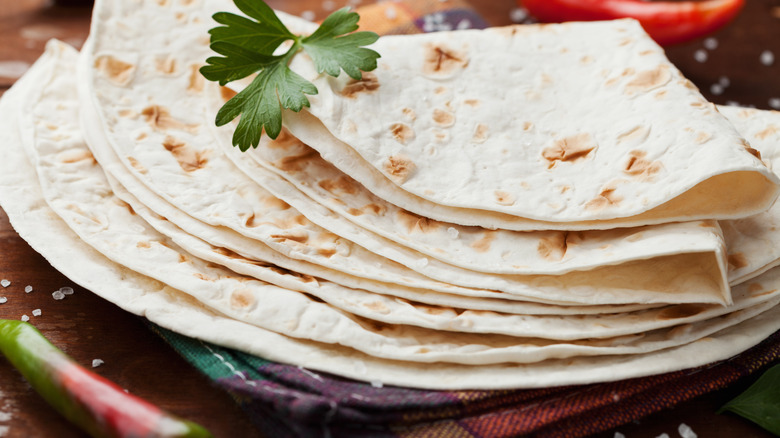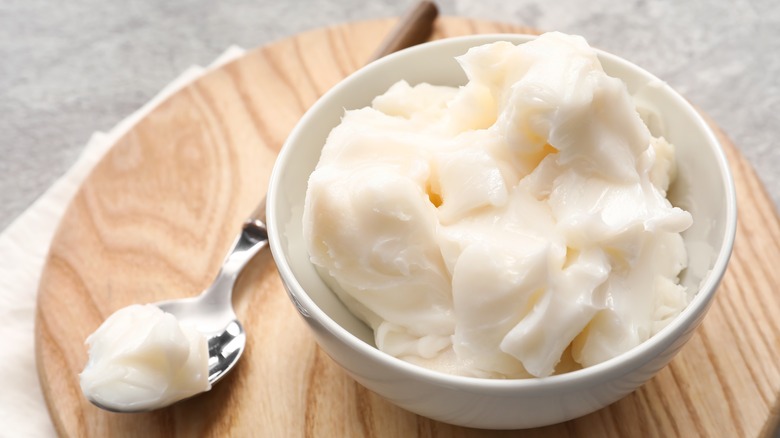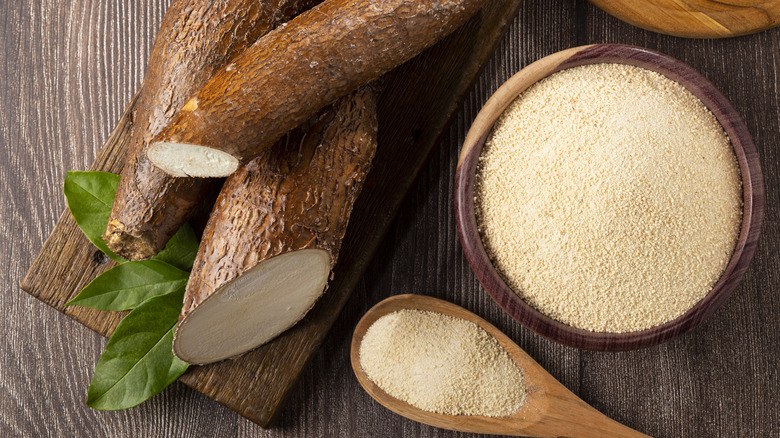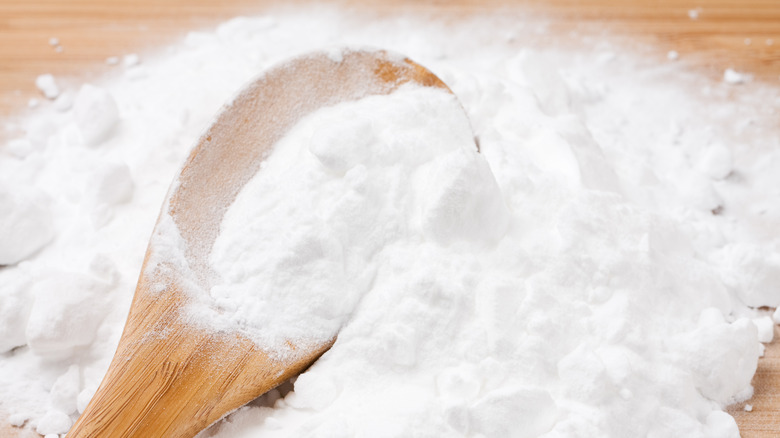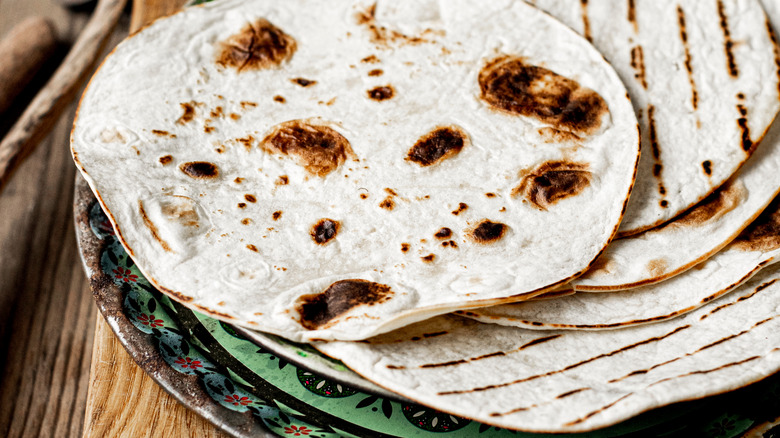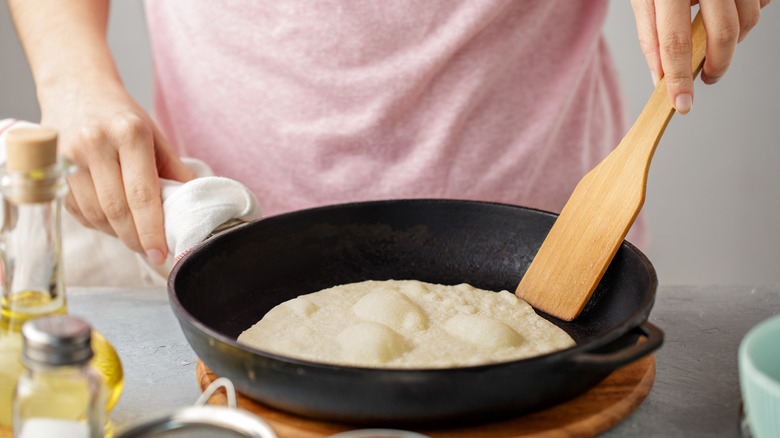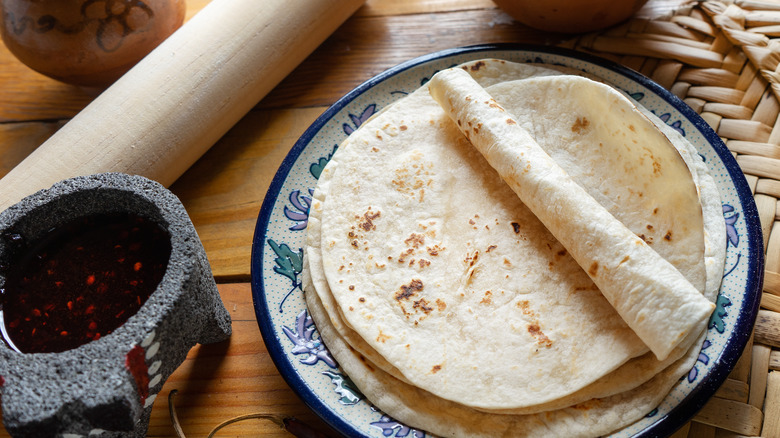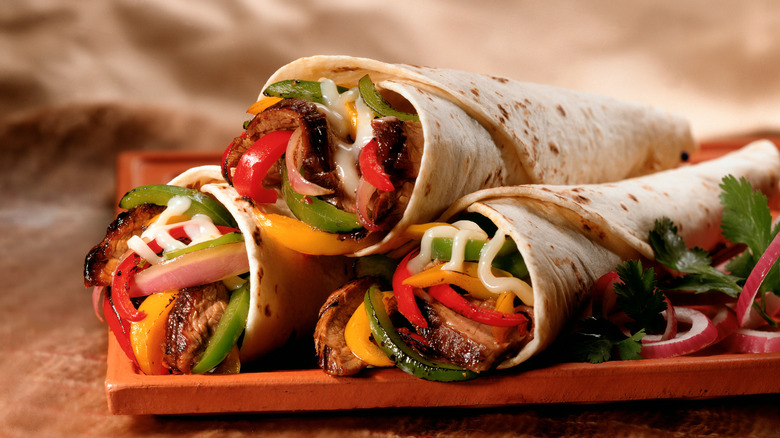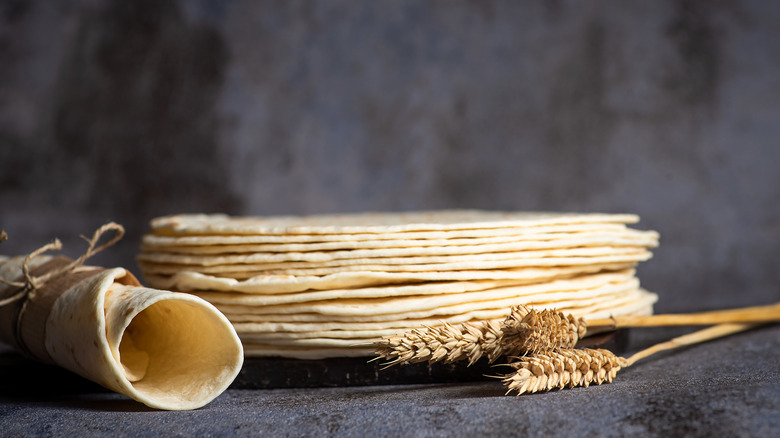The Biggest Mistakes Everyone Makes With Homemade Flour Tortillas
While it's certainly easy to find good-quality store-bought flour tortillas, making them at home affords a particularly delicious result. Indeed, many home cooks have been spoiled by the top-quality house-made flour tortillas in a restaurant and tried their hand at making them at home. That said, embarking on such an adventure is not without risks. Many home cooks have seen their efforts questionably rewarded with tortillas that are over- or under-cooked, too thick or too thin, too brittle or too delicate to hold up to the heft of your favorite burrito.
But luckily, according to Laurent Tourondel who just opened eLTacobar, a taco restaurant in the Hamptons, flour tortillas are "definitely easy to make at home," especially seeing as they are far less fragile than their corny cousins.
"Corn tortillas are much more difficult to make as there are many nuances in the process," agrees the Culinary Team at Tacombi and Vista Hermosa, led by Chef Carmen Miranda, who here offers insights with help from Chef Jason DeBriere. They notably cite the nixtamalization process, which requires time and patience, as just one of the factors making corn tortillas tougher to master.
"When making flour tortillas, if you have a solid recipe and follow it accordingly and have a rolling pin and a griddle you should be okay," they say. If you have these tools — and you're aware of common missteps — you should soon be on your way to flour tortilla mastery.
Not using the right fat
Look at the ingredients list of any flour tortilla recipe, and it'll prove itself quite short and sweet: flour, salt, water, and some kind of fat. But when it comes to this last ingredient, experts say you should keep your eye out for a very specific indication. Pork fat or lard, according to Laurent Tourondel, is far superior for the flavor and texture of the final tortilla. Using enough, he says, will keep them tender and moist.
Of course, if you'd prefer your tortillas to be plant-based, you do have other options.
"Traditionally flour tortillas are made with manteca or rendered pork fat," says Carmen Miranda and Jason DeBriere, who nevertheless opt for avocado oil in their recipe. "And since we make an exceptional flour tortilla, yes, you can make great flour tortillas without pork fat."
Tourondel agrees, noting that while lard is better for flavor and texture, a flour tortilla can indeed be successfully made with oil. The only no-no in his books? Butter, which has a much lower smoke point than either oil or lard, and thus isn't ideal for the perfect blistered flour tortilla.
Not using cassava flour in the mix
When we evoke flour tortillas, we're usually talking about wheat flour, but for Carmen Miranda and Jason DeBriere, another flour merits inclusion: cassava. Cassava is also known as yuca, a starchy root that's highly nutritious and ideal for free-from diets, seeing as it boasts no gluten, grain, or nuts. Given its neutral flavor and natural elasticity, cassava flour and tapioca flour — the latter made from the same plant, albeit ground to a finer, starchier texture — has also become a common base for paleo wraps and tortillas.
While Miranda and DeBriere don't exclusively rely on cassava flour in their flour tortillas, they do use some alongside organic wheat flour. This addition, according to DeBriere, lends elasticity and moisture to the final tortillas, rendering them more pliable and less likely to dry out. As a rule of thumb, using whole cassava flour will render a slightly less glutinous texture than relying on tapioca flour.
Not using hot enough water
Most flour tortilla recipes call for hot water in the base, which has multiple benefits when bringing the dough together. Not only does it allow you to dissolve the salt more easily so that it distributes evenly throughout the dough, but it will also more evenly incorporate the fat, ensuring that you end up with a tender, soft tortilla.
Many home cooks make the mistake of using water that isn't quite hot enough, relying, for example, on water from the hot tap. Not only is it dangerous to drink or cook with water from the hot tap given the potential for lead contamination, according to the EPA, but hot tap water probably isn't hot enough. The water should be boiling hot to lend the right texture to the finished dough. If you're kneading it by hand, go as hot as you can handle it without burning yourself.
Not considering baking powder
Baking powder may not be at the top of your mind when considering your flour tortilla recipe. After all, baking powder serves as a leavening agent, lending airiness to cakes and height to cookies. But it can also feature in your flour tortillas, according to Laurent Tourondel, who says that whether you use it or not is really down to personal preference.
"Some flour tortilla recipes call for baking powder. Some don't," he says, noting that using baking powder gives the tortillas "a little bit of puffy volume." Others claim that adding baking powder to tortillas doesn't make much of a difference at all. So, you be the judge! If you'd like your tortillas to puff up slightly while cooking, consider adding a bit of baking powder to the recipe. If, on the other hand, you'd rather have a totally flat flour tortilla, you can leave it out.
Cooking flour tortillas for too long
One of the major mistakes folks make when making flour tortillas at home is overcooking them, which, according to Carmen Miranda and Jason DeBriere, is far more common than undercooking.
"Flour burns easier than corn and is a lot less forgiving," they say, noting that, on the contrary, an undercooked tortilla will be doughy and taste of raw flour.
Burning is only part of the issue when it comes to overcooking flour tortillas. Once overcooked, the tortillas become dry and brittle, cracking easily, the team explains. And a brittle tortilla does not a delicious burrito make.
Both the Culinary Team at Tacombi and Vista Hermosa and Laurent Tourondel say that this problem can be easily solved by better managing your heat source. Tourondel notes that to avoid accidentally overcooking your tortillas, your best bet is to cook them over medium heat. This will ensure that you cook them through without accidentally pushing them into the burned or brittle territory.
Using the wrong pan
Cooking your tortilla calls for the perfect surface — not any old pan will do. Carmen Miranda and Jason DeBriere prefer a plancha or griddle for cooking flour tortillas, providing an even heat that means your tortilla will cook perfectly over the entirety of its surface. That said, they add that home cooks can also rely on a good nonstick skillet; just be sure to choose one with a thick aluminum core, which will still give you that even heat distribution.
Laurent Tourondel, too, likes nonstick for his tortillas, but he's also a fan of good old-fashioned cast iron. Well-seasoned cast iron will be naturally nonstick, and make it easy for you to flip your tortillas as you go. And as an added bonus, if you're using your tortillas to make homemade steak fajitas, the pan can do double duty in cooking both the tortilla and the tasty filling.
Making flour tortillas the wrong size
Tortillas come in all shapes and sizes, but as a general rule of thumb, flour tortillas will usually be larger than corn tortillas, which are often just 5 to 6 inches in diameter. This comes down not only to the fact that corn tortillas are often used as the base for tacos, as opposed to flour tortillas, more common for burritos, but also because corn tortillas are more delicate. The larger you make a corn tortilla, the more likely it is to fall apart. Thanks to its gluten structure, a well-made flour tortilla thankfully doesn't boast the same delicacy.
That said, there are a few staple sizes for flour tortillas, which largely come down to the way you plan to use them. According to Carmen Miranda and Jason DeBriere, quesadillas and breakfast tacos are happiest on 7 to 8-inch tortillas, while burritos need larger 10 to 12-inch tortillas.
Using them in the wrong dishes
While you certainly could pile almost anything on a homemade flour tortilla and have it come out delicious, the reality is that if you want to stick to tradition, flour tortillas are perfectly paired with a handful of fillings. This stems from the fact that flour tortillas are far more common in northern Mexico, where wheat was introduced in the 17th century. It's thus unsurprising that flour tortillas are far more common in border cuisine recipes.
"Quesadillas are great on flour tortillas," says Carmen Miranda and Jason DeBriere of Tacombi and Vista Hermosa, evoking that classic born in northern Mexican Sonora. Homemade burritos, too, demand the pliability and sheer size of a flour tortilla.
That said, aside from these two staples, Miranda and DeBriere note that they "actually prefer corn to flour for just about all dishes." Not only do they assert that tacos should always be served on corn tortillas, but even certain quesadilla recipes, such as queso Oaxaca and squash blossoms, don't shine nearly as well on a flour tortilla base.
"Those flavors were made for corn tortillas," they say.
Not storing leftover flour tortillas properly
The problem of having too many flour tortillas isn't necessarily a common one, according to Jason DeBriere. "At my house, we don't have many leftover flour tortillas," he says. "They are eaten daily, usually in the morning with butter, cinnamon, and sugar. My kids eat them all the time." That said, should you end up with a surplus, he says that they'll keep at least two weeks in the fridge and can even be frozen. (Laurent Tourondel recommends keeping them a far shorter time — no more than two days in the fridge.)
As for what to do with them, the possibilities are endless. Both DeBriere and Tourondel note that the day after making them, they make a phenomenal base for a breakfast taco or burrito; DeBriere is a particularly big fan of stuffing them with scrambled eggs. Tourondel, meanwhile, offers a laundry list of delicious ways to use slightly staler tortillas, including nachos, enchiladas, and pizza crust. And of course, you can think outside of the box!
"You can use flour tortillas for so many dishes, not just Mexican cuisine," says the team from Tacombi and Vista Hermosa. "Use them alongside curries or kids' lunches with hummus and veggies or peanut butter, honey and bananas. Endless possibilities!"
